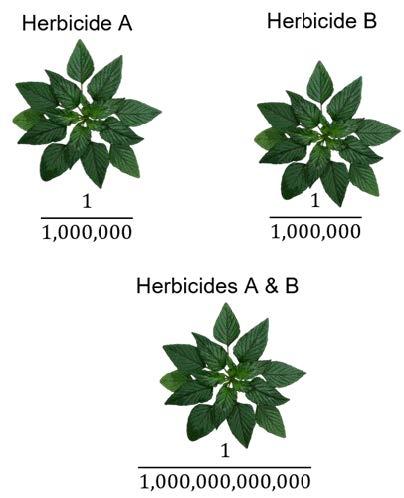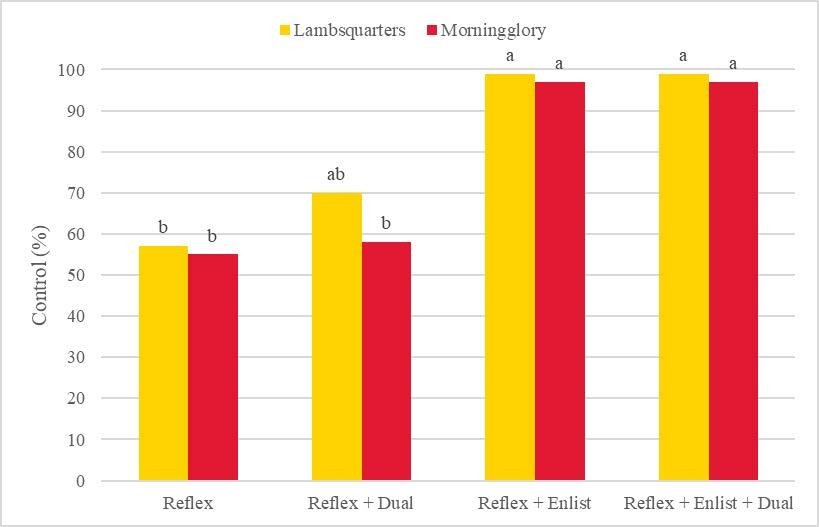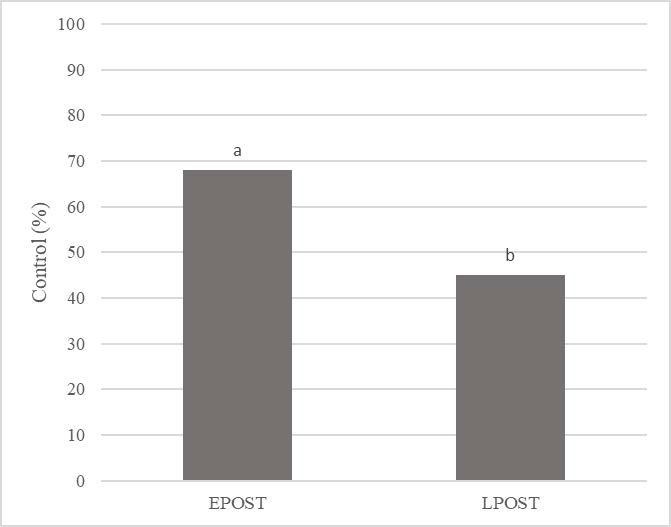Assessing Herbicide Tank Mixes for Postemergence Weed Control in Soybean

Research was conducted at the Wye Research and Education Center to evaluate herbicide tank mixes for postemergence weed control in herbicide-tolerant soybean. As herbicide-resistant weeds continue to drive weed management decisions, options are needed to not only provide effective weed control, but also preserve the value of available herbicides.
Tank mixing multiple, effective herbicide groups is one tactic that can be used to impede herbicide resistance. By including multiple, effective herbicide groups when making an application, there is a lower probability that a weed species will develop resistance to all herbicides used (Fig. 1). Furthermore, tank-mixing different herbicide groups can have a synergistic effect, where the combined effect of two or more groups is greater than the effects of each herbicide alone. For example, previous research has shown Enlist One + Liberty to be more effective in controlling as common ragweed and Palmer amaranth, compared to each individual herbicide.
This research examined the effectiveness of tank mixing of herbicides with foliar (2,4-D, fomesafen) and residual (fomesafen, S-metolachlor) for early and late postemergence weed control in soybean. Plots (10 ft. x 25 ft.) were arranged in a randomized complete block design with 4 replicates. Herbicide treatments consisted of applying Reflex (fomesafen), Reflex + Dual Magnum (S-metolachlor), Reflex + Enlist One (2,4-D) or a three way mix of Reflex + Dual + Enlist One (Table 1). The entire study area received 1 pt/A Dual Magnum within 24 hours of soybean planting Enlist E3 soybeans on June 4, 2024. Early postemergence (EPOST) applications were made 2 weeks after planting and late postemergence (LPOST) applications 4 weeks after planting.
| Herbicide(s) | Rate | Timingᵃ |
|---|---|---|
| Reflex | 1.5 pt | EPOST or LPOST |
| Reflex + Dual | 1.5 pt + 1.5 pt | EPOST or LPOST |
| Reflex + Enlist | 1.5 pt + 2 pt | EPOST or LPOST |
| Reflex + Enlist + Dual | 1.5 pt + 2 pt + 1.5 pt | EPOST or LPOST |
ᵃ Herbicide treatments were applied early postemergence (EPOST) 2 weeks after planting or late postemergence (LPOST) 4 weeks after planting soybeans on June 4, 2024.
Broadleaf Weed Control
Application timing did not affect common lambsquarters or morningglory control. Reflex + Enlist or Reflex + Enlist + Dual controlled common lambsquarters better compared to Reflex alone, and morningglory species better than Reflex or Reflex + Dual (Fig. 2).
Applications made EPOST provided better control compared to applications made LPOST (Fig. 2), but giant foxtail control varied from 38% to 78%, with no significant differences among herbicide treatments (Fig. 3). It should be noted that Enlist One does not control grasses. Both Dual Magnum and Reflex can provide some grass activity, but only if applied PRE. Better foxtail control with EPOST treatments could be attributed to overlapping residual control with these treatments. Overlapping herbicides is a tactic that involves sequential applications of herbicides with soil-residual activity to lengthen herbicidal activity before the first herbicide dissipates. As Dual Magnum was included in both PRE and POST applications, the EPOST applications likely provided better overlapping residual control due a shorter application window between the PRE and POST applications (2 weeks for EPOST and 4 weeks for LPOST).
This research highlights the value of adding multiple herbicide groups to the tank at the time of POST applications (Fig. 4). While additional work is needed to confirm the results of this study, the following factors should be considered when deciding which herbicides to include in the tank:
- The types of weeds are prevalent in the field. Should the spray program focus primarily on broadleaf weeds, grasses, or both?
- The emergence period for the weeds being controlled. Will a single POST application negate the need for additional treatment, or should an herbicide with residual activity be included?
- Each herbicide must be effective alone on the target weed. Including multiple herbicides will not be as effective if a weed already has significant resistance to one of the herbicides in the mix.


